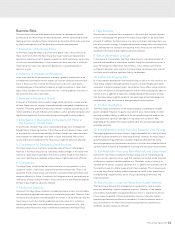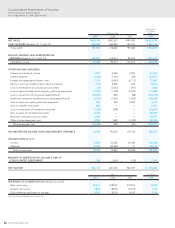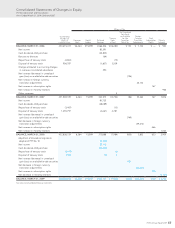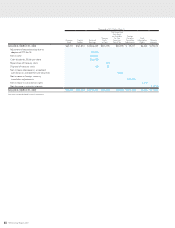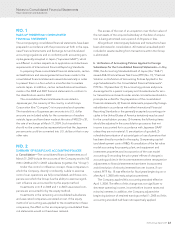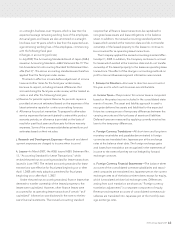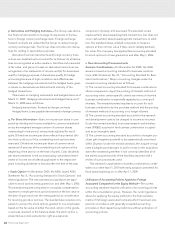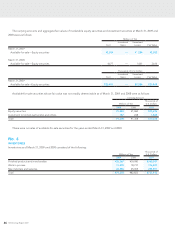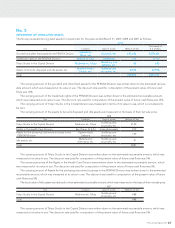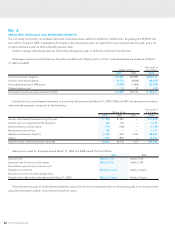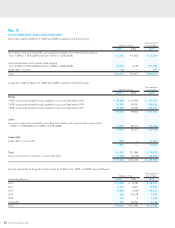Pentax 2009 Annual Report Download - page 63
Download and view the complete annual report
Please find page 63 of the 2009 Pentax annual report below. You can navigate through the pages in the report by either clicking on the pages listed below, or by using the keyword search tool below to find specific information within the annual report.
61
HOYA Annual Report 2009
NO. 1
BASIS OF PRESENTING CONSOLIDATED
FINANCIAL STATEMENTS
The accompanying consolidated financial statements have been
prepared in accordance with the provisions set forth in the Japa-
nese Financial Instruments and Exchange Act and its related
accounting regulations and in conformity with accounting prin-
ciples generally accepted in Japan (“Japanese GAAP”), which
are different in certain respects as to application and disclosure
requirements of International Financial Reporting Standards.
In preparing these consolidated financial statements, certain
reclassifications and rearrangements have been made to the
consolidated financial statements issued domestically in order
to present them in a form which is more familiar to readers
outside Japan. In addition, certain reclassifications have been
made in the 2008 and 2007 financial statements to conform to
the classifications used in 2009.
The consolidated financial statements are stated in
Japanese yen, the currency of the country in which Hoya
Corporation (the “Company”) is incorporated and operates.
The translations of Japanese yen amounts into U.S. dollar
amounts are included solely for the convenience of readers
outside Japan and have been made at the rate of ¥98.23 to $1,
the rate of exchange at March 31, 2009. Such translations
should not be construed as representations that the Japanese
yen amounts could be converted into U.S. dollars at that or any
other rate.
NO. 2
SUMMARY OF SIGNIFICANT ACCOUNTING POLICIES
a. Consolidation—The consolidated financial statements as of
March 31, 2009 include the accounts of the Company and its 102
(100 in 2008 and 67 in 2007) subsidiaries (together, the “Group”).
Under the control or influence concept, those companies in
which the Company, directly or indirectly, is able to exercise
control over operations are fully consolidated, and those com-
panies over which the Group has the ability to exercise signifi-
cant influence are accounted for by the equity method.
Investments in 4 ( 8 in 2008 and 1 in 2007) associated com-
panies are accounted for by the equity method.
Investments in the remaining unconsolidated subsidiaries
and associated companies are stated at cost. If the equity
method of accounting was applied to the investments in these
companies, the effect on the accompanying consolidated finan-
cial statements would not have been material.
Notes to Consolidated Financial Statements
Hoya Corporation and Subsidiaries
The excess of the cost of an acquisition over the fair value of
the net assets of the acquired subsidiary at the date of acquisi-
tion is being amortized over a period of 20 years or less.
All significant intercompany balances and transactions have
been eliminated in consolidation. All material unrealized profit
included in assets resulting from transactions within the Group
is eliminated.
b. Unification of Accounting Policies Applied to Foreign
Subsidiaries for the Consolidated Financial Statements—In May
2006, the Accounting Standards Board of Japan (the “ASBJ”)
issued ASBJ Practical Issues Task Force (PITF) No. 18, “Practical
Solution on Unification of Accounting Policies Applied to For-
eign Subsidiaries for the Consolidated Financial Statements”.
PITF No. 18 prescribes: (1) the accounting policies and proce-
dures applied to a parent company and its subsidiaries for simi-
lar transactions and events under similar circumstances should in
principle be unified for the preparation of the consolidated
financial statements, (2) financial statements prepared by foreign
subsidiaries in accordance with either International Financial
Reporting Standards or the generally accepted accounting prin-
ciples in the United States of America tentatively may be used
for the consolidation process, (3) however, the following items
should be adjusted in the consolidation process so that net
income is accounted for in accordance with Japanese GAAP
unless they are not material: 1) amortization of goodwill; 2)
scheduled amortization of actuarial gain or loss of pensions that
has been directly recorded in the equity; 3) expensing capital-
ized development costs of R&D; 4) cancellation of the fair value
model accounting for property, plant, and equipment and
investment properties and incorporation of the cost model
accounting; 5) recording the prior years’ effects of changes in
accounting policies in the income statement where retrospective
adjustments to financial statements have been incorporated;
and 6) exclusion of minority interests from net income, if con-
tained. PITF No. 18 was effective for fiscal years beginning on or
after April 1, 2008 with early adoption permitted.
The Company applied this accounting standard effective
April 1, 2008. The effect of this change was not significant to
decrease operating income, income before income taxes and
minority interests. In addition, the Company adjusted the
beginning balance of retained earnings at April 1, 2008 as if this
accounting standard had been retrospectively applied.




